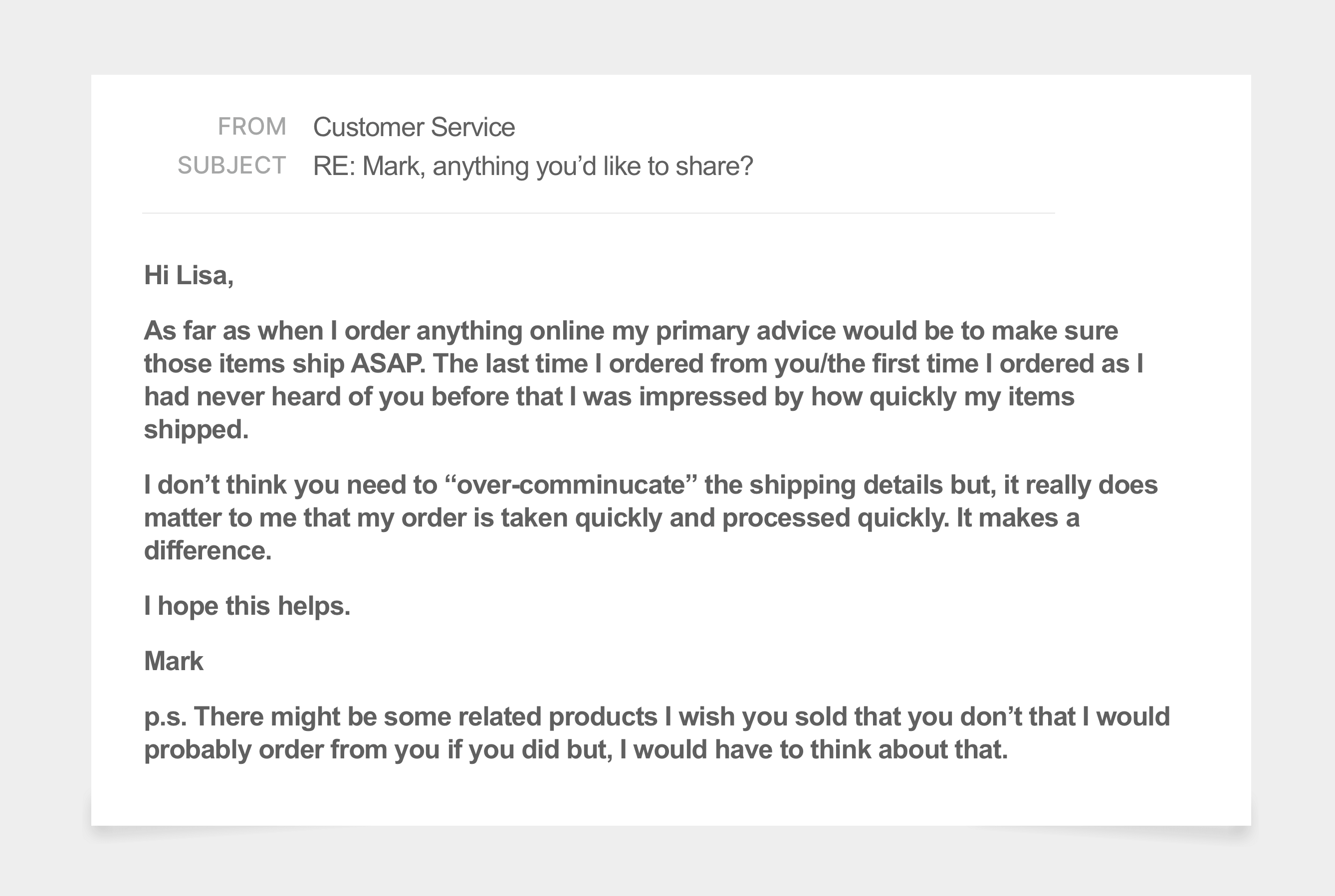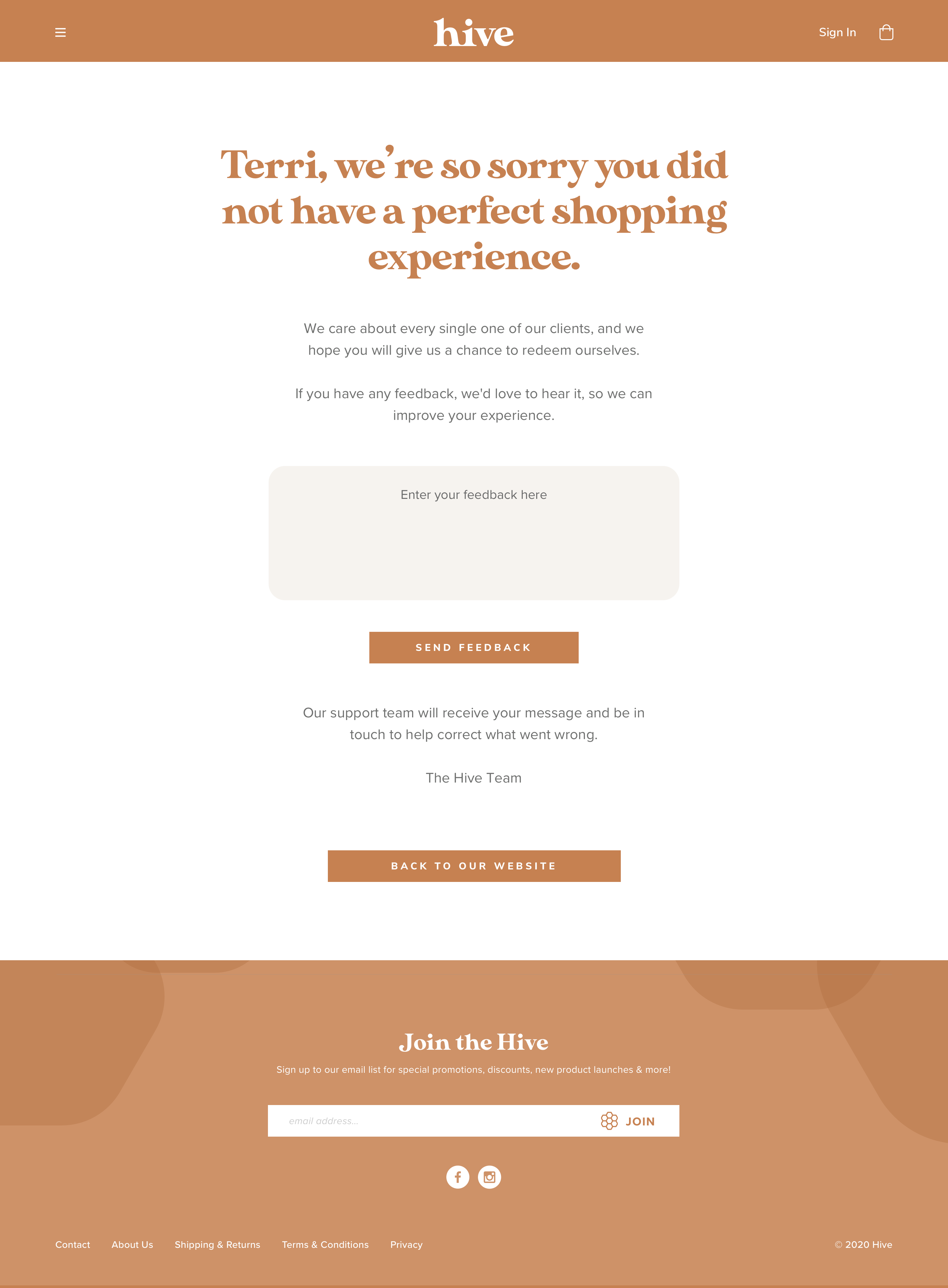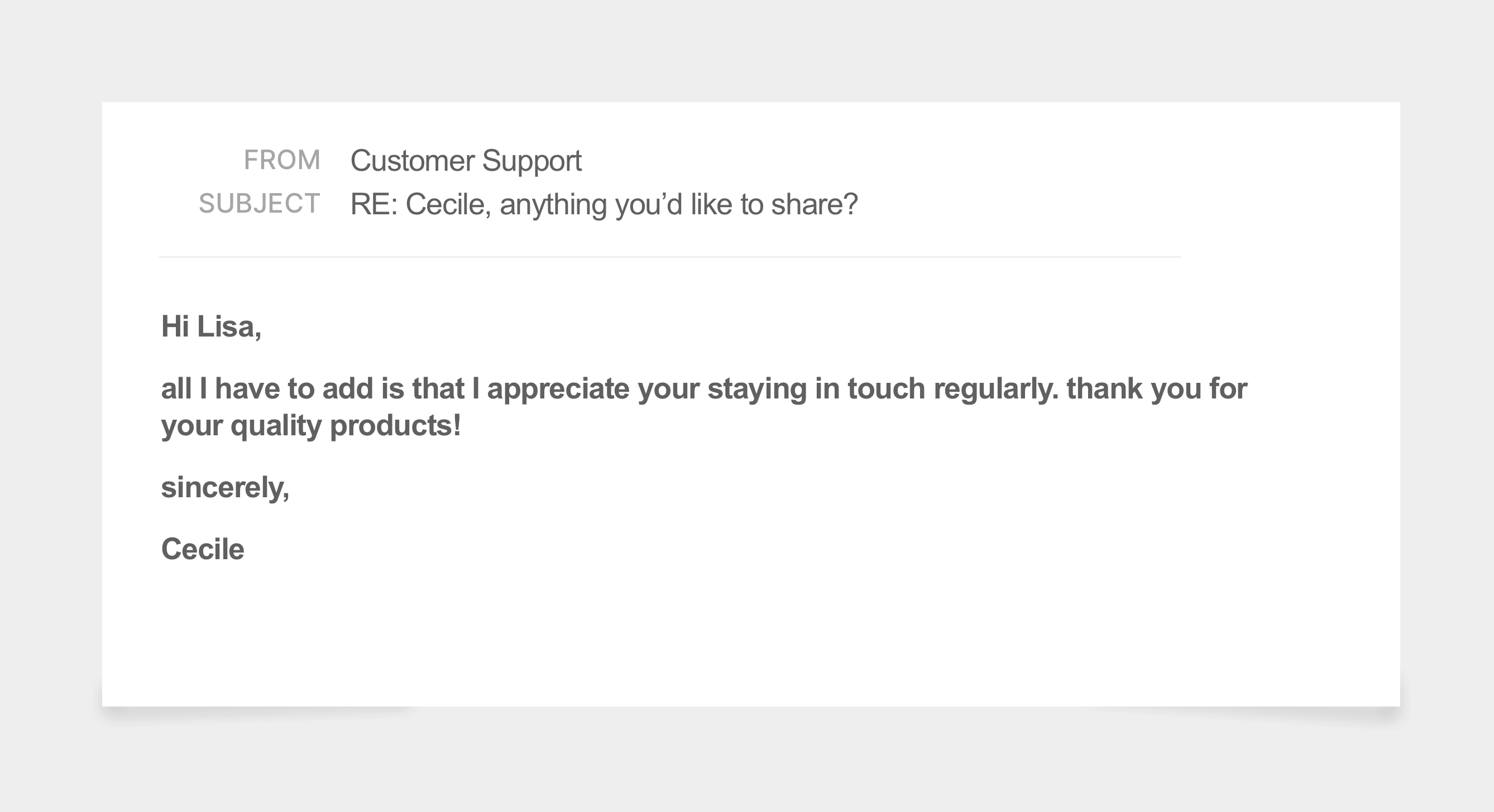It's one thing to ask for your customer's opinion. It's another story if you act on it immediately.
We're about to show you a three step automated process that will put all other feedback systems to shame. It will enable you to gauge how customers are feeling so you can react in the most fitting way. It looks something like this:
- Ask your customers for feedback via an email (NPS score)
- Send them to a unique landing page
- Follow-up with a personalized email
And all of it is automated.
This system walks your customers through a thoughtful journey thanks to a highly-personalized experience designed to increase their lifetime value and loyalty. It allows customers to provide honest feedback, providing you direction on how to improve the shopping experience with your brand.
Take a look at the response one of our brands received from someone going through this 3-step journey:

Helpful, right?
Now read the note sent from an "unhappy" customer, that enabled this brand to make things right:

By setting up this strategy, this brand enabled 41% of negative responders to explain their issue and get the help they needed (helping turn unhappy customers into happy customers), and 8.6% of positive responders to write store reviews. Creating your own system like this is a no-brainer.
What is a Net Promoter Score?
The Net Promoter Score system (or NPS) asks your customers to rank you from 0 to 10. You then categorize your responders into three buckets depending on their answer:
- 0-6: Detractors
- 7-8: Passive
- 9-10: Promoters
Your score is calculated with a simple formula: percentage of Promoters minus the percentage of Detractors. (You can also use a free online calculator to determine your score – surveymonkey, delighted, NPS calculator.) The concept is simple. You're simply trying to quantify how your customers feel about your brand.
Why NPS?
Calculating your NPS is a valuable benchmark to track over time.
It's also an easy question for customers to answer. It takes no explaining, very little thinking, and can be accomplished with one click. According to SuperOffice, 68% of customers don’t buy again because they think a company doesn’t care about them. You can get in front of this problem with the NPS question, which gives your customers a voice and a way to express themselves.
Moreover, since you're just asking for a number, it's unambiguous and you can know exactly how to respond.
Step 1: Asking for Feedback
The first part of this journey consists of asking your customer the prescribed Net Promoter Score question: How likely are you to recommend us to your friends?
You can do this with tools such as Swell or Stamped.io. We prefer building it out directly within Klaviyo.
Here's what it looks like:

Trigger this email once your average customer has had enough time to experience your product.
Technical note: Each number links to one of three landing pages (we’ll share more on this below). UTM parameters are used to track which number they click, and to pass it back to Klaviyo as a custom property. This allows you to send segmented follow-up emails in the future. (Again, more on this below!)
Step 2: Landing Page
Once a customer selects a score, it’s your chance to shine.
Now is your opportunity to follow up in the most appropriate way.
When a customer clicks any of the numbers, direct them to a unique landing page that acknowledges the receipt of their response.
Here's where you start personalizing experiences, depending on their score.
For Detractors:
Start by apologizing for whatever led to this low score. Saying sorry goes a long way. Why? Because people are more likely to forgive a company if they’re offered an apology. It also positions your brand as more human and caring.

But on top of that, you can make it very easy for your unhappy customers to get the help they need to resolve their issues.
Studies show that 70% of unhappy customers are likely to repurchase if their problem gets fixed. That’s why this page includes a feedback form that goes directly to your Customer Support team. This way you can quickly jump in and take care of the issue.
At the very least, you're providing unhappy customers with a channel to direct their anger – other than public reviews!
Keep in mind it takes about 12 positive reviews to make up for 1 negative; so you'll want to divert that indignation at all costs!
For Passives:
These customers aren't over-the-moon about your brand, but they're not unhappy. This landing page focuses on thanking them for their feedback.
Here, you can acknowledge they didn't give you the highest score. Make it known that you're always trying to improve. This will justify your request for more information and make your Passive customers feel valued by involving them in the decision process to help your brand go from average to awesome.

For Promoters:
This is where you want to bring out the big guns!
Someone just told you they love your company. It’s the perfect opportunity to collect quality, enthusiastic testimonials. So we use this page to ask them to write a public review.
To simplify this process, show your customer the products they bought to refresh their memory and link directly to the "write a review" section on each product page.

.
Step 3: Email Follow Up
Customizing their experience with a unique landing page after a customer selects a score is key. But you can go a step further!
Once you've registered their score in Klaviyo (as a custom property), trigger segmented follow up messages.
Why? Because your customer just took time out of their day to help you by answering your question. The least you can do is send them a "thank you" follow up note. This is a powerful way to make your customers feel closer to your brand and to make a positive impression.
For Detractors:
If your detractor responds to the customer support form, their message should go directly to the support team who will make sure to reach out asap.
But for those who don't take advantage of that form it doesn't hurt to follow up with a friendly automated note from someone on your team. This gives you another chance to show that you go the extra mile to make things right.

For Passives:
Use this as an opportunity to open the conversation and follow up with a thoughtful email making yourself easily available.
Customers like to see that you care: 73% of consumers say friendly customer service made them fall in love with a brand. So this email could turn a Passive into a Promoter!

For Promoters:
Go above and beyond by thanking your Promoter once again. In case they didn't write a review yet, remind them of how they can easily share their experience about their products.

Now let’s look at some real results
Take a quick look at results from a brand we helped to implement these systems.
To determine overall results, we’ll start by looking at the open rates for each follow up email.
- Detractor: 72%
- Passive: 59%
- Promoter: 59%
These way-above-average open rates tell us that customers are successfully interacting with this third touchpoint.
When we look at the landing pages, we see the following:
- 41% of Detractors engage with the feedback form
- 5.2% of Passives submitted additional feedback
- 8.6% of Promoters have left at least one review on the store
In short, the numbers show that these systems are getting very high engagement from customers!
Qualitatively, you can expect to receive very specific and eye-opening feedback from your customers:


Most stores do some of this: they ask for reviews, and they have a customer support team available. They might even say thank you here and there. But you'll certainly stand out by doing it all together in this personalized automated email journey, while simultaneously gaining direction on how to improve your overall shopping experience.
